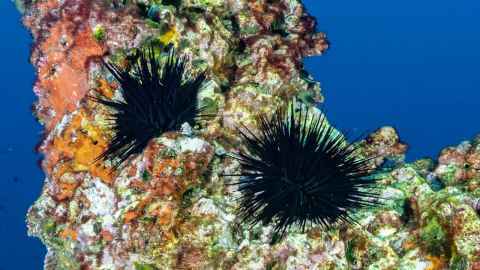AI `urchinbot’ will find sea urchins ravaging our coasts
3 July 2024
Scientists at Leigh Marine Laboratory are developing a tool for quickly tracking the spread of sea urchins.

The longspined sea urchin, Centrostephanus rodgersii, is increasing in numbers in north-eastern New Zealand waters after already decimating areas off south-eastern Australia. While native, the increase in its population is linked to increasing ocean temperatures.
A New Zealand and Australian team led by Dr Arie Spyksma of the University of Auckland’s Leigh Marine Laboratory, is developing algorithms to rapidly assess underwater imagery covering 10s or 100s of kilometres of coastline impacted by kelp declines and sea urchin expansion.
The work, which has been progressing for almost a year, has been funded from a US$131,000 (about $215,000) grant from Climate Change AI (CCAI), a global nonprofit.
The project pulls together cross-disciplinary expertise from Waipapa Taumata Rau, University of Auckland, including Spyksma, Dr Kelsey Miller (Leigh Marine Laboratory) and Dr Katerina Taskova (School of Computer Science), along with colleagues from the University of Tasmania, and a firm involved in applied machine learning, Greybits Engineering.
“For now, we’ve got a deficit of data in Aotearoa, and this project will help to plug the gap, helping us to move quickly in managing the threat,” says Spyksma. “We have a large coastline and conducting science underwater is slow. With the changes happening so quickly, utilising AI tools to speed up this process is invaluable,” adds Miller

There’s a worldwide problem with increasing sea urchin populations turning large areas of coastal ecosystems into underwater deserts called “urchin barrens”.
Unlike New Zealand’s endemic sea urchin kina, which typically forms barrens between 3m and 15m below the waterline, the longspined sea urchin has the potential to form barrens to as deep as 40m to 50m below the waterline – significantly expanding the size of the area under threat.
The urchin monitoring tool, unofficially dubbed “urchinbot,” scans photos of the seafloor and can find, detect, and determine different species of sea urchins almost as well as the human eye.
In addition, the scientists are developing AI for monitoring other species within coastal reef ecosystems (kelps, seaweeds and invertebrates), although that’s a tougher task. While sea urchins stand out against barren reefs, the disparate elements of a complex marine environment are not as easily assessed.
Once complete this project, bringing together the “urchinbot” with the broader species classifier, aims to provide a toolkit for New Zealanders to rapidly identify and address longspined sea urchin impacts before it is too late. It would be available for use by iwi, hapu and community groups driving local marine recovery efforts.
Likewise, Australia would be able to assess the success of current longspined sea urchin management actions, while keeping an eye on further signs of kelp forest decline.
Media contact
Paul Panckhurst | media adviser
M: 022 032 8475
E: paul.panckhurst@auckland.ac.nz